Hanover Bald Eagle Blog # 9
In partnership with Pennsylvania Game Commission and Comcast Business .
As Liberty and Freedom are putting together their (potentially) final nest preparations for the year, it’s hard not to notice how instrumental their feet and beak are to nest building. Even with the snow storm and blustery cold, the bald eagles have continually brought sticks and nesting materials to their Eyrie. This week we were able to witness their coordination first hand
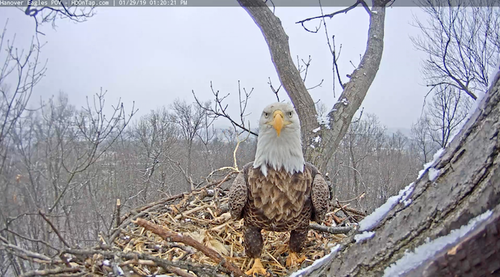
The bald eagle has four strong toes, three forward facing, and one rear facing called the hallux, each with a sharp talon. Their featherless, scaled, bright yellow feet possess special abilities. Like many other raptors, their feet and toes are used as tools. A common trait of all birds is the interlocking tendon mechanism which allows birds to grasp onto items (a branch, food, etc.), without using any energy. Inside of their foot is a tendon that has thousands of tiny, rigid tubercules. The neighboring tendon contains transversely aligned openings that slant towards the base of the toe or foot. As the foot flexes (opens), the tendon is pulled tight and then as the foot grasps, the tubercles become locked into the openings. Similar to how zipper pieces fit together, the tendons are like two serrated edges running against each other.
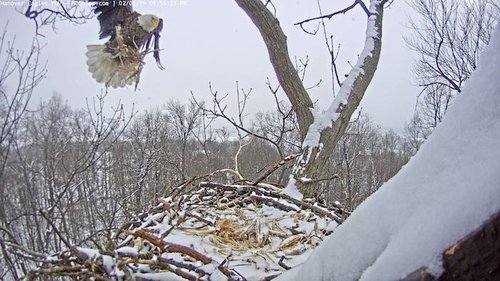
Basically, to open their foot, the birds are using energy. Their natural, resting foot position is with toes fully clenched. However, eagle feet evolved to have that ability plus one more. Not only can they “lock” that tendon into place, they can maneuver their “wrist” around while it is locked. To relate it to the human arm, if you had your arms straight out in front of you with locked tendons, you would have your hands tightly clenched into a fist with your wrist straight (because the tendon runs up your arm). But if you were an eagle, you would be able to move your wrist around to move sticks, adjust food, eat, and hunt while keeping a firm grip on your chosen item without wasting energy
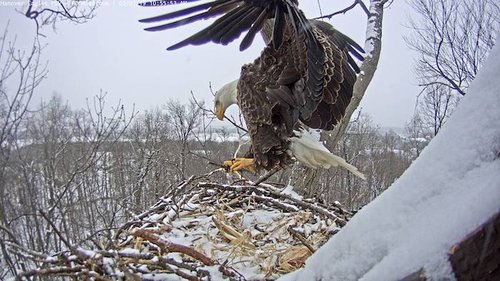
In addition to maneuverability, on the underside of the foot are spicules. These tiny bumps help them hold onto prey during flight - which is especially important when it comes to finding a safe place to consume those slippery fish!
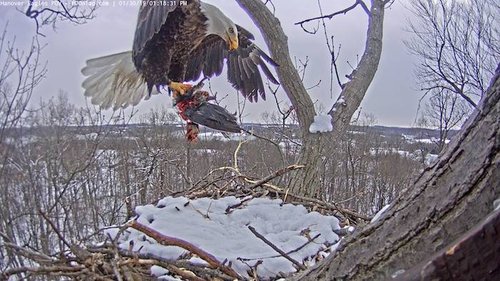
Speaking of consuming, this predators beak is essential to its hunting strategy. The sharp curved edge is uniquely designed to tear and rip flesh off of fish prior to consumption. Although eagles do not use their beak to catch prey, such as our smallest local raptor, the American kestrel, they would be unsuccessful without this adaptation. As an additional tool for nest construction, the beak helps to rearrange the nesting material, and sometimes to strip the bark off branches to fill in small gaps in the nest. Liberty and Freedom have certainly been hard at work perfecting their nest for future eggs and eaglets!
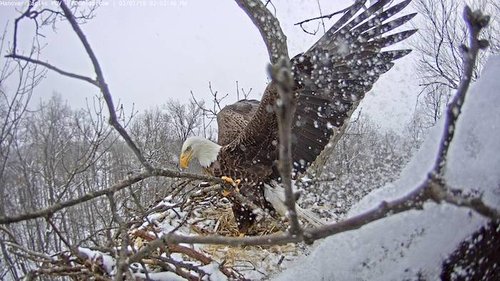
THANK YOU HAWK MOUNTAIN FOR THIS WEEK'S BLOG ENTRY!

RETURN TO HANOVER BALD EAGLE BLOGS
WATCH THE HANOVER BALD EAGLE LIVE CAMS
For over 20 years, HDOnTap has provided live streaming solutions to resorts, amusement parks, wildlife refuges and more. In addition to maintaining a network of over 400 live webcams, HDOnTap specializes in design and installation of remote, off-grid and otherwise challenging live streaming solutions. Contact press@hdontap.com for all media needs, including images and recordings.